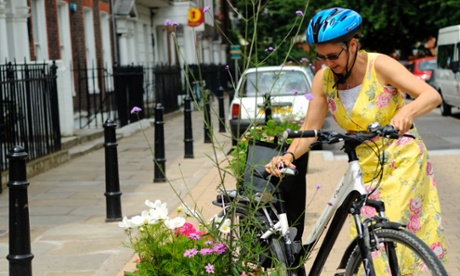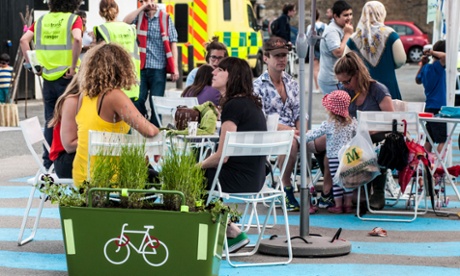The streets belong to you. Yes, you. I’m talking to you – the parent, the kid, the homeowner, the canine walker. They’re not just for that hotted up racer or loved ones station wagon. They are not meant to be dedicated to visitors jams and speeding traffic. They’re for you.
Streets make up 80% of the available open area in our towns and cities and provide enormous prospective as a community resource, as a location to meet our neighbours, a place to socialise and play. In other countries around the globe, people feel comfy using their streets in the same way we use the nearby park or playground.
In France at lunchtime you may see neighbouring store owners bringing out tables and chairs into the street to sit down, eat together and appreciate each other’s organization before continuing with the afternoon’s company. In America, men and women “sit out on the stoop” – the veranda at the front of their house.
This generates a very social and normal kind of neighbourhood observe. As the popular urbanist and writer Jane Jacobs put it, “eyes on the street” are the very best way to make the streets feel risk-free, as the presence of people deters criminal or anti-social behaviour. If your veranda is, in impact, a residing room in which you host visitors, then you are far a lot more probably to hold it nicely maintained. This social use of the street conveys a message that this is a spot that is loved, in which individuals live and which encourages individuals passing by way of to display respect to it.
But at present, compared with other countries, it appears that fairly few of us in the Uk have a sense of connection with the streets the place we dwell and the neighbours with whom we share them. As Guardian datablog reported, the United kingdom is ranked as the 2nd least neighbourly country in the EU. The street provides a space to create these neighbourly connections but we typically choose to shelter within for our meals and are fearful to allow our young children to play out on the street – even in good weather.
So why will not we see much more creative, lively utilization of urban streets in the United kingdom? In the past, streets were crowded with little ones and skipping ropes and bikes. 70% of grownups nowadays in the United kingdom “played out” on the street as kids compared with just 21% nowadays. Historically streets had been utilised for games of football, trade, entertainment and even public executions. For centuries, there was a legal duty on citizens to “mend their techniques” by preserving the highway in front of your property. The Statute of Winchester 1555, for example, needed landowners to wash the streets and even specified the number of buckets of water to be used and the regularity. The implication was that the street was in some way in the ownership of the house owner, in result an extension of the homestead.
Over time, this historic duty on the homeowner to preserve their streets devolved to the parish. The most important alter came with the Highways Act 1959 which moved the duty to fix highways from the “inhabitants at huge” and transferred it to highways authorities (the local council) and also established the principle that streets would be maintained at the public cost. Maybe this outsourcing has contributed to a sense that the street is mainly the duty of the council and by extension the establishment – the street belongs to them, not us, the men and women who dwell there and use it most frequently.

Coupled with this, above the final half century, auto ownership has drastically enhanced. In 2012, the overall motor automobile traffic volume of 302.6bn automobile miles was above 10 times greater than in 1949 (28.9bn car miles). Scientific studies display that dread of targeted traffic is a primary cause why dad and mom will not allow their young children travel to college on their personal, and the volume of site visitors in your street is a essential figuring out factor on no matter whether you know your neighbours.
Something has to modify. Men and women ought to truly feel empowered to get better ownership of their streets and use them in assortment of methods. Sadly, numerous communities have misplaced connection with the place they live, as evidenced by the expertise that has been the catalyst for Sustrans neighborhood street design and style projects. Men and women inform us about lazy parking that blocks the pavement and the accidents waiting to occur. We hear of neighbours who unashamedly throw rubbish and even dog waste in excess of their fence into the street. What’s going on? Is this symptomatic of a wider disconnection with the locations and men and women in which we reside? Why will not men and women come to feel a better sense of connection to the streets ready to use and form them in techniques which reflect their potential as a local community resource?
At Sustrans, we are striving to assist communities recapture this sense of ownership, to reimagine and redesign streets as spots for men and women. We often kickstart this method by bringing men and women collectively in the street, throwing up some bunting or generating a pop-up park with potted plants and AstroTurf. This permits people to perform with and knowledge the street’s potential. Then more than time, we work hand-in hand with them to identify what they want to see in their street, be it far more trees or slowing site visitors. We experiment – we use straw bales to try distinct layouts, paint the street with colour and develop daring patterns to present what is attainable. It will take time, but there is a enormous sense of community achievement and goodwill when all the hard function leads to modifications which really effect people’s lives for the better.

In Clapton Terrace in Hackney this has led to a new neighborhood plaza with new planters and trees which also calmed traffic speeds. We surveyed the residents, and the proportion who felt the street was risk-free for their street to play in, increased from 14% before the task to 48% afterwards. In a lovely touch, the local community also now have a regular local community picnic on a piece of green space that was opened up as element of the re-style.
In yet another undertaking in north London a series of local community-led modifications to the street layout lowered regular everyday visitors volume by ten% and substantially diminished targeted traffic speeds. Empowered by the project some members of the community set-up an arts group, which has gone on to generate a walking street gallery with an array of colourful and vibrant artwork pieces during the neighbourhood.
These are places the place the auto utilized to dominate, but now they’re spaces that belong to individuals just like you. So following time you peep out your front window and lament the cars squeezed into every single pocket of area or reminisce about your childhood adventures on the street, it is really worth remembering that street belongs to you. Yes, you.
Finlay McNab is nationwide projects co-ordinator for street layout, Sustrans.
Interested in finding out far more about how you can live far better? Consider a seem at this month’s Reside Greater Challenge here.
The Dwell Better Challenge is funded by Unilever its concentrate is sustainable living. All content is editorially independent except for pieces labelled advertisement feature. Discover out far more right here.
Streetwise? Go outside - your road belongs to you and your neighbours
Hiç yorum yok:
Yorum Gönder